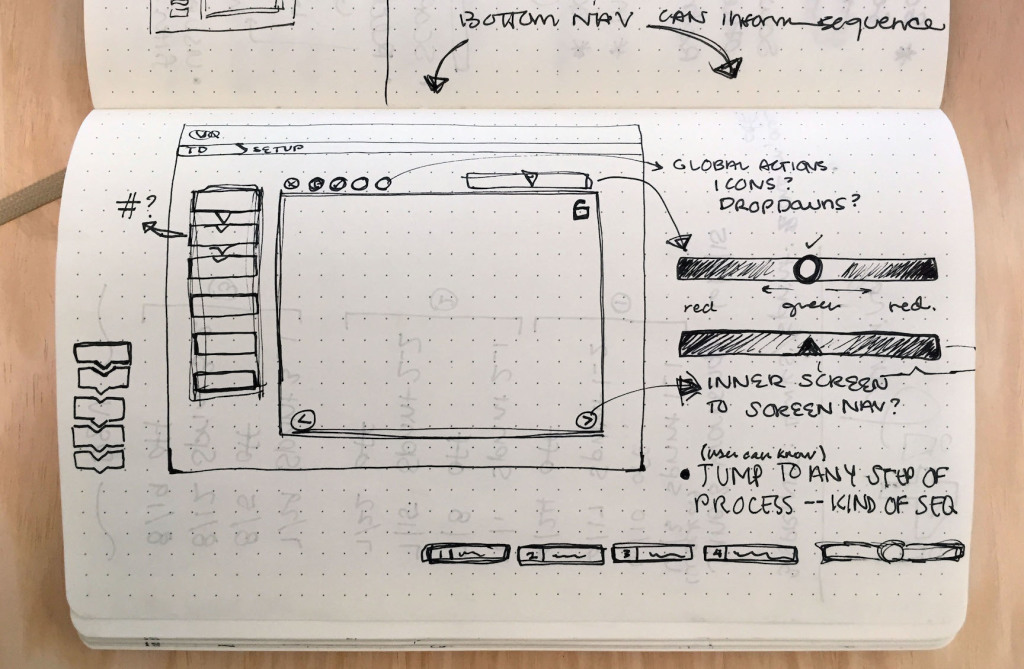
19 Jun But first, sketch.
Just wave your magic wand and make it look pretty!
I can’t tell you the number of times this has been said to me. Often, people don’t realize that design doesn’t just happen with a mouse (I suppose this is my magic wand)—a few clicks and voila! In reality, there is a lot of thinking that happens before working on the computer. It’s all about going back to the basics.
Sketching is simple and doesn’t come with features. These days, technology has taken over and believe me I am a proponent with my Macbook, iPhone, and iPad—but taking pen to paper offers benefits that just can’t be substituted.
There are no artboards.
Sketching doesn’t constrain me to carefully selected artboard dimensions in Illustrator. I can use as many sheets of paper and make my sketches as big or small as I want without being bounded by presets. If I start sketching a screen and find that the rectangle initially drawn isn’t working, I just draw a new rectangle. The mental process of what to enter in the width and height boxes can come later. Moving a pen around on paper (or marker on a whiteboard) allows your mind to work without interruption by other steps that can hold you up more than you realize.
The key is to just let the ideas flow—there’s no reason to be constantly switching tools in illustrator—select shape, drag out rectangle, resize rectangle, select cursor, select text tool, place cursor- don’t even get me started on the distraction of fonts and colors. All of these actions may seem small, but they take time and don’t allow the mind to wander as freely.
I have one tool and one surface.
There is no criticism.
Sketching is as basic as it gets, there are no whistles and bells to make it look pretty (maybe some colored markers if I have them on hand?) The rawness of it doesn’t feel decisive. When I see an idea on the screen, it’s natural to start critiquing. It automatically feels polished. A line drawing of a large rectangle with some small squares inside of it, maybe a circle or some lines? Not so polished. But it conveys an idea, which is all that is needed at step 1.
Sketching can be a braindump of anything that may come to mind—don’t make it perfect, leave room for interpretation. Imperfections and misinterpretations can lead to new ideas and sometimes the out of the box ideas are the best paths to the right solutions. The freedom of moving your pen around on paper works hand in hand with exercising the mind and sparking new ideas.
Filtering can come later.
There is no delete button.
There is no quick and easy way to delete a sketch. Yes, trash cans exist and pencils can erase, but sketching can be archival if you allow it to be. It’s beneficial to look back and be able to trace my train of thought. The ability to review my sketches from the beginning of a process, see notes jotted in the margins, questions along the way, is useful.
I may be midway through a project, implementing a sketch on the computer when I realize it doesn’t work the way I intended. I can look back on my sketches and maybe decide to work off that first scheme I initially ruled out. This wouldn’t be possible if I deleted it.
Old ideas may spark new ones; an idea for one project may have a role in another one.
Finally…
Don’t limit sketching on a project to project basis either. Sketching of any sort helps to keep the mind moving and ideas flowing—whether you’re doodling a portrait of a person on the train to work or wireframing a dashboard.
The act of drawing utilizes multiple parts of our brain, causing interactions that flow into the area where we create, plan, and decide. People strongly believe that drawing enhances visual perception. Milton Glaser (acclaimed designer, hint: I ♥ NY logo) stated,
“It is only through drawing that I actually look at things carefully and the act of drawing makes me conscious of what I’m looking at.”
We stare at the computer for hours on end, morning through afternoon. Often a change of medium can help kickstart creativity.
Some references:
Draw Yourself Happy: Drawing, Creativity + Your Brain | Robin Landa
Milton Glaser Draws & Lectures | Video by C. Coy
